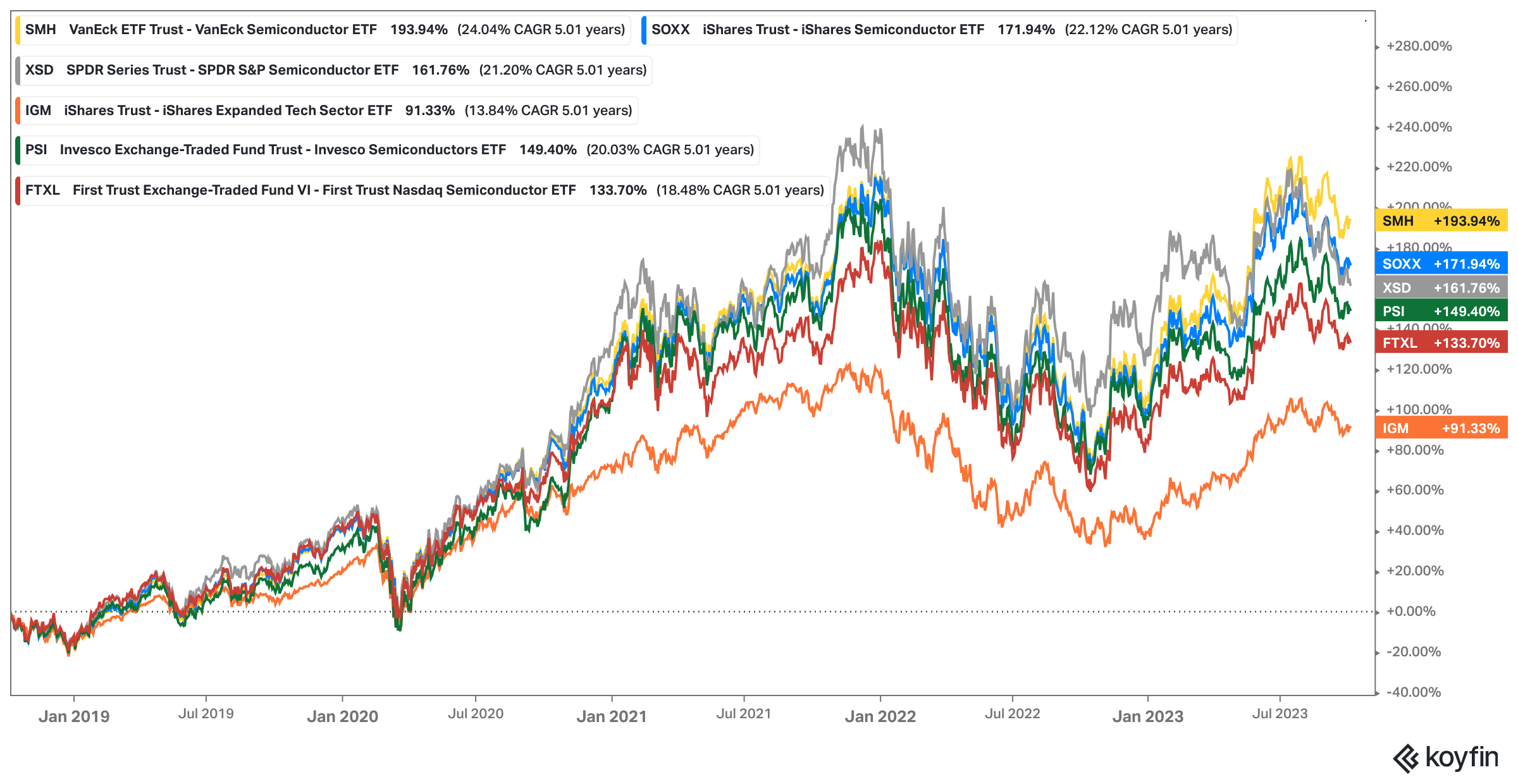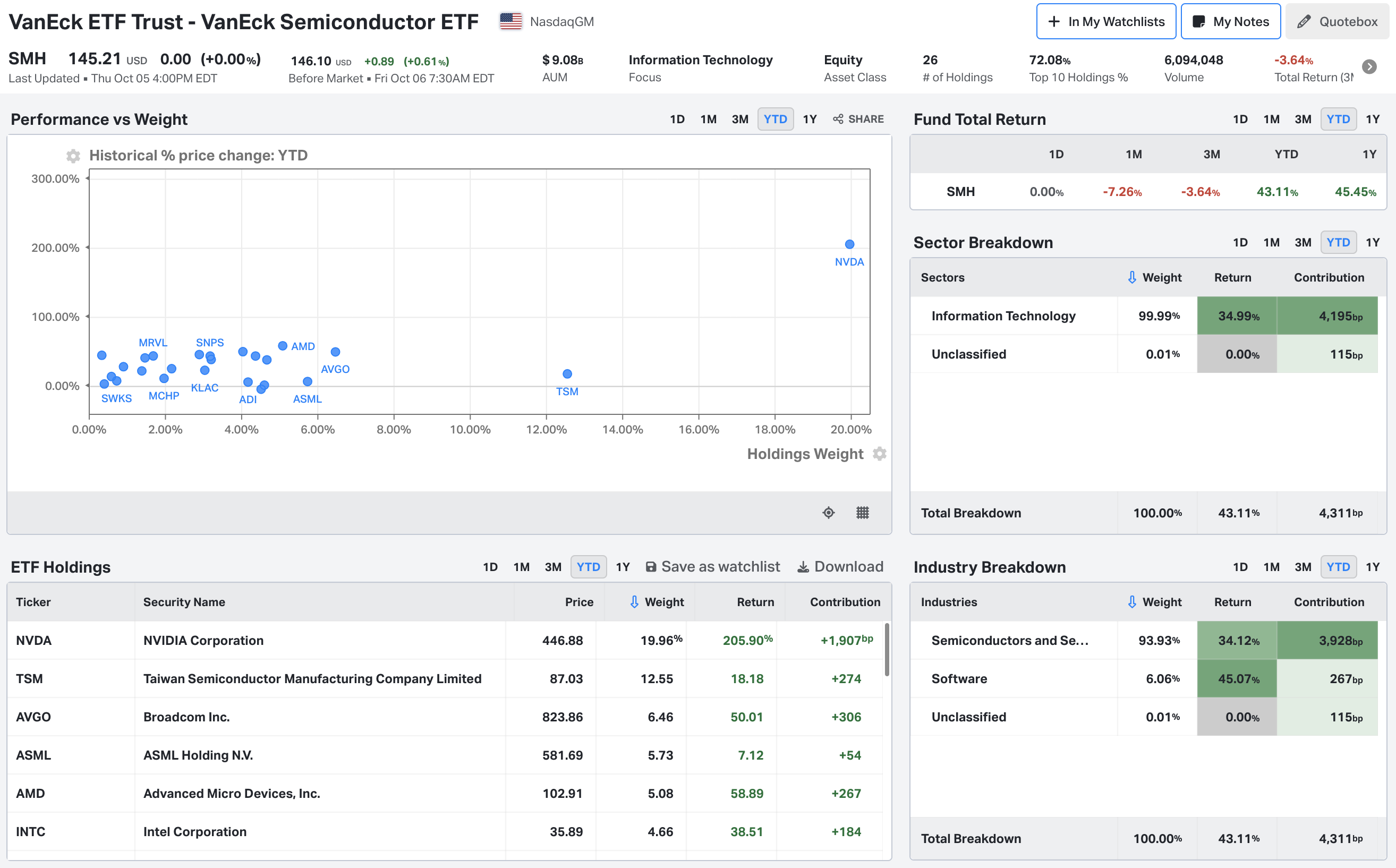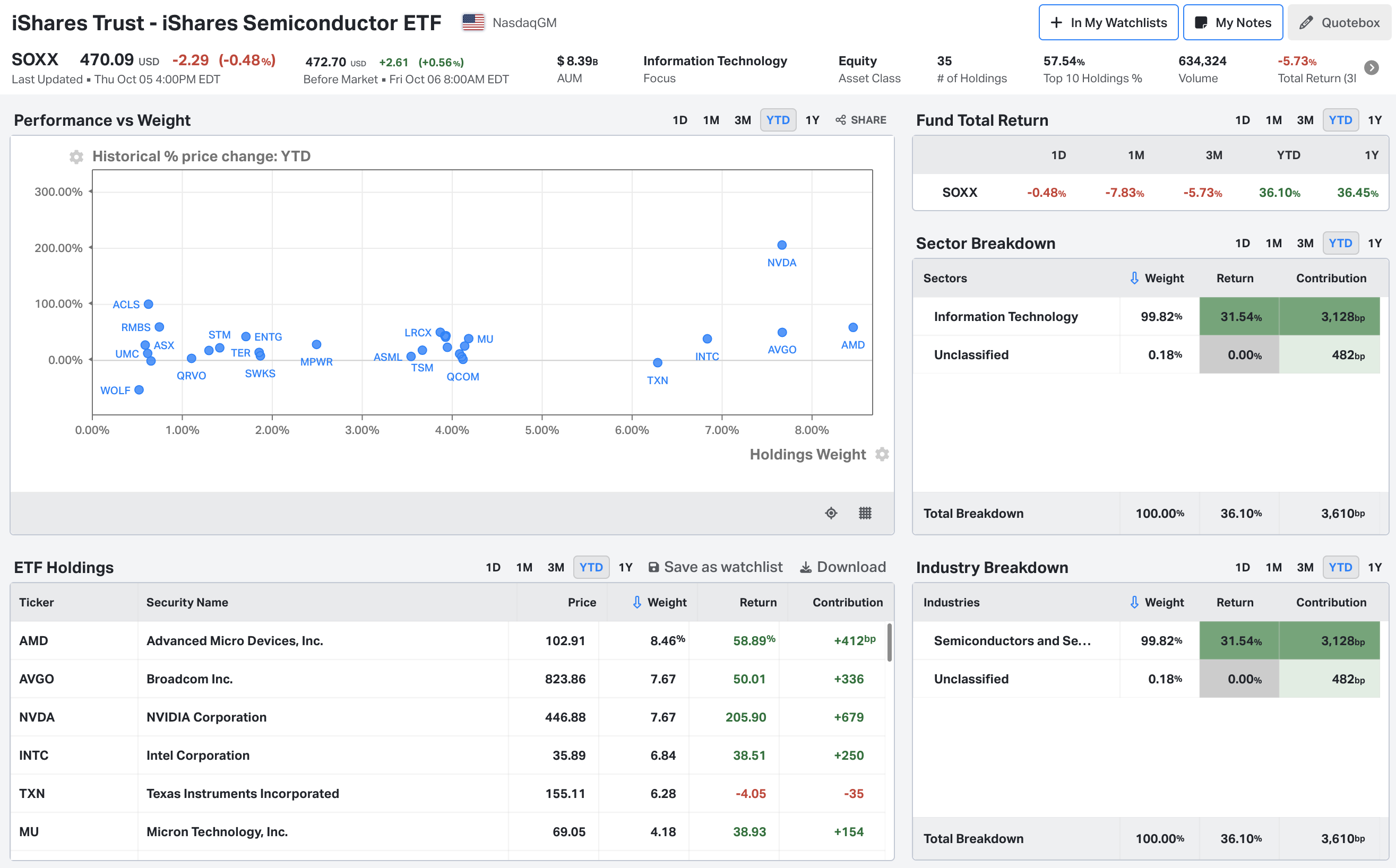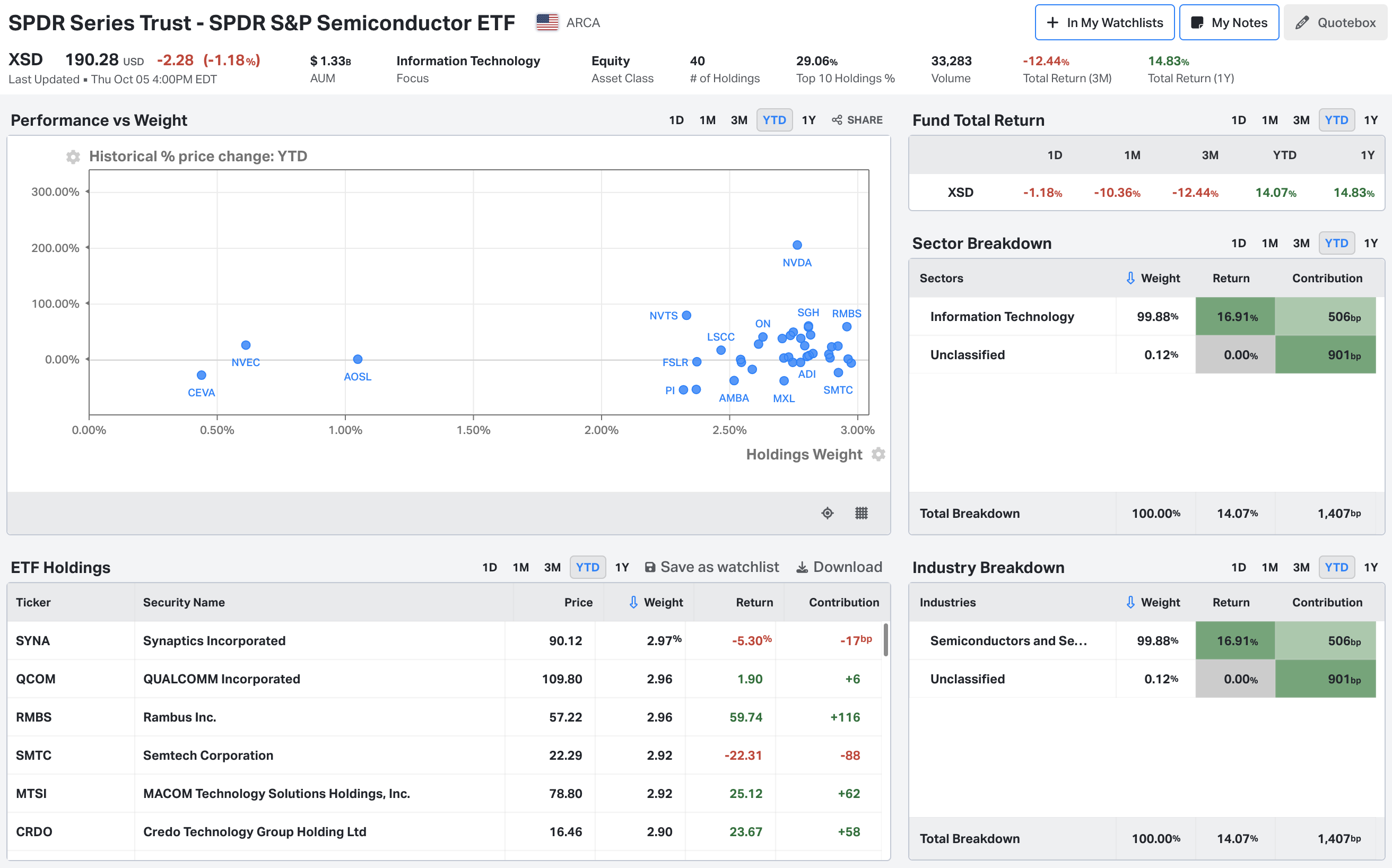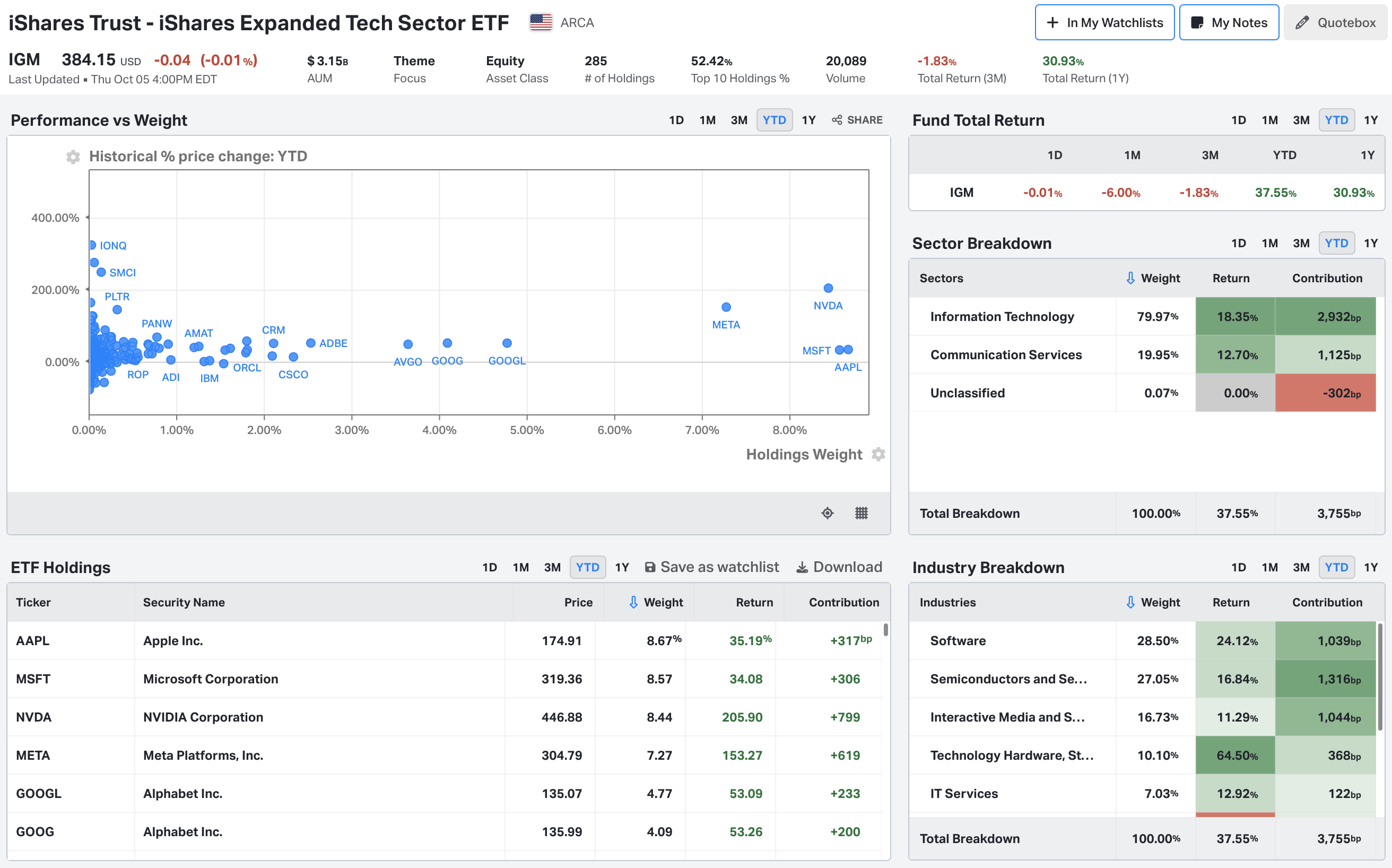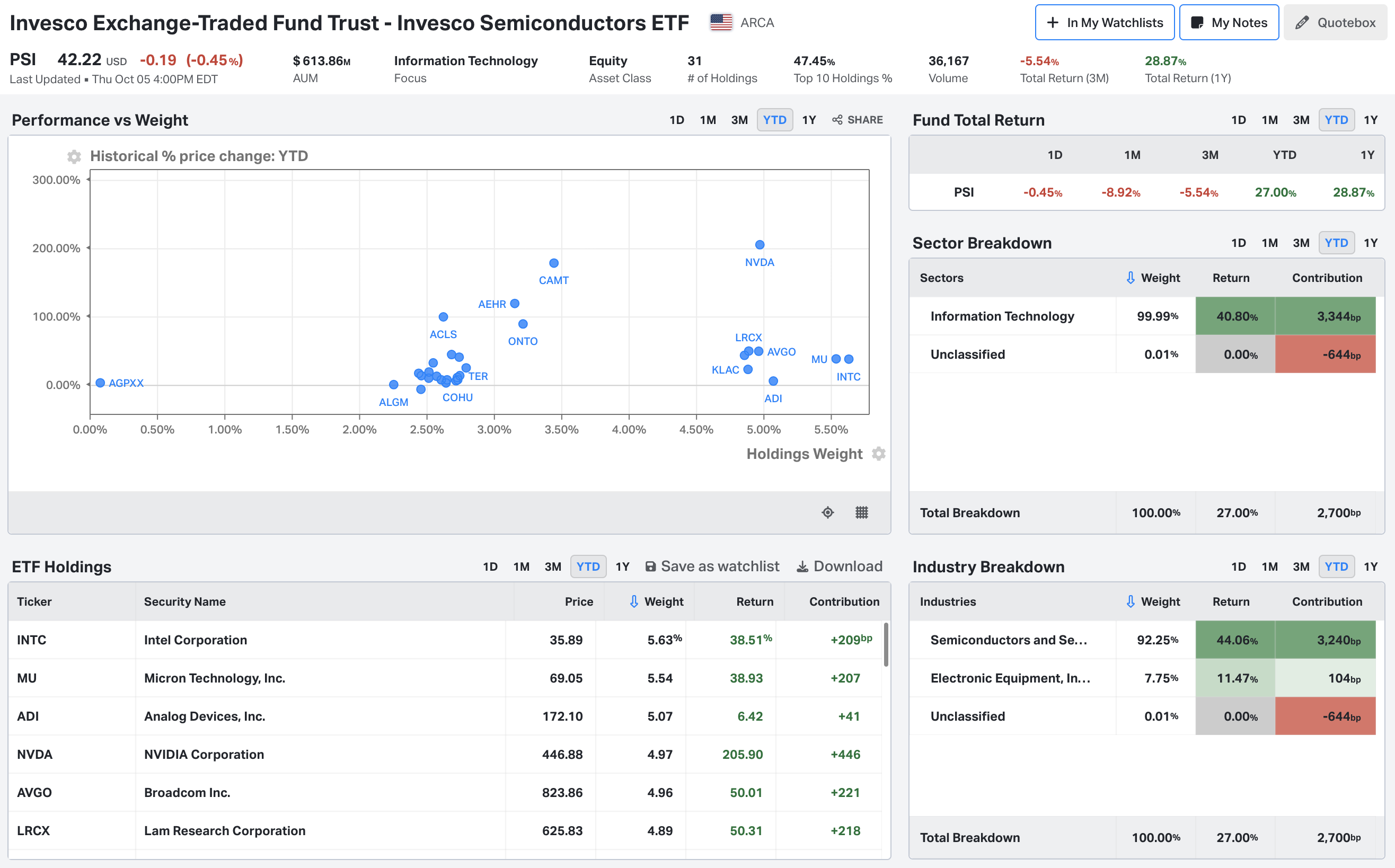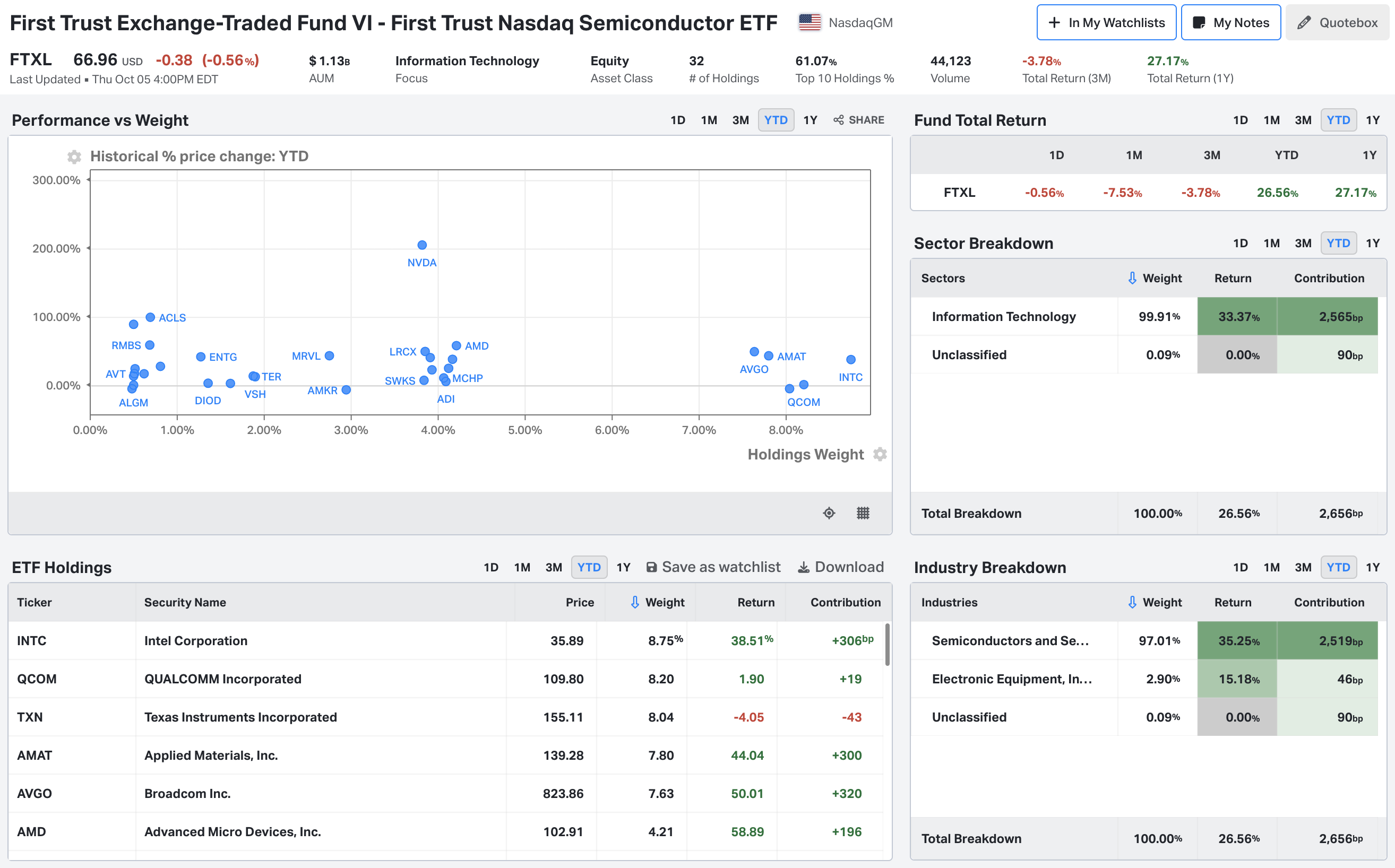6 Best Semiconductor ETFs: Chips On The Table
One theme that has garnered a lot of attention over the last few years is semiconductors. They are an integral component of the technologies that we all love, and they are equally important for the ongoing development of technology. The industry touches many corners of the world and is not isolated to the individual companies that manufacture these chips. Smartphones, vehicles, computers, healthcare, the gaming industry, cybersecurity, and many more are all reliant on these chips, and investors are more frequently looking for ways to gain exposure to those producing them, as well as the beneficiaries of semiconductor innovation.
Picking individual semiconductor stocks is one option, but for those who are new to the space, or simply don’t have the capacity to pick individual stocks, there are a number of funds on the market today that can give you the exposure you need.
Identifying the Best Semiconductor ETFs: Our Strategy
To curate the list of the best semiconductor funds, we used the Koyfin ETF screening tool to search for funds sharing a winning combination of traits.
- Low Fees: Because these are specialized funds, they exhibit higher expense ratios than your typical low-cost broad market index fund. However, we picked the ones with the lowest fees amongst their peer group.
- Large Assets Under Management: All of our funds have at least $500 million in assets. Four have between $600 million and $5 billion in AUM and two have more than $8 billion in AUM.
- No Leverage: There are funds out there, such as SOXL and SOXS that offer investors 3x leveraged exposure to semiconductor stocks. There are also funds like NVDL which offer 1.5x long Nvidia exposure. While these types of funds may offer outsized performance in the short run, we decided to exclude leveraged funds from our selection process.
- Widely Available: There are many funds out there offering exposure to the semiconductor market. We focused on funds that are widely available and are not restricted to certain brokerages, advisors, or pension schemes.
The 6 Best Semiconductor ETFs of 2023
Name | Ticker | AUM | Holdings | Expense Ratio |
|---|---|---|---|---|
VanEck Semiconductor ETF | SMH | $9.1B | 26 | 0.35% |
iShares Semiconductor ETF | SOXX | $8.4B | 35 | 0.35% |
ISPDR S&P Semiconductor ETF | XSD | $1.3B | 40 | 0.35% |
iShares Expanded Tech Sector ETF | IGM | $3.2B | 285 | 0.4% |
Invesco Dynamic Semiconductors ETF | PSI | $613.9M | 31 | 0.57% |
First Trust Nasdaq Semiconductor ETF | FTXL | $1.1B | 32 | 0.6% |
*Data as of October 6th, 2023
Ready to monitor these funds closely? Keep scrolling to the end of the article to uncover simple tips for creating your own watchlist!
VanEck Semiconductor ETF (SMH)
Vaneck’s Semiconductor ETF, SMH, is one of the largest, at $9.1 billion in AUM, but also one of the most concentrated with just 25 holdings. Focused entirely on US-listed semiconductor companies, the fund has seen more than $7 billion in cumulative inflows so far in 2023 as investors look to gain exposure to the sector. The fund is heavily concentrated in Nvidia, which accounts for 20% of the holdings. Other large weightings include Taiwan Semiconductor (13%), Broadcom (6%), ASML Holdings (6%), and Advanced Micro Devices (5%). More than 70% of the fund is allocated to just 10 companies.
The concentration has worked in the fund’s favor. SMH has outperformed all of the other semiconductor ETFs on our list over trailing 1Y, 3Y, 5Y, 10Y, and 20Y time periods, as of the time of writing. The fund has one of the lowest expense ratios, 0.35%, and offers investors a dividend yield of 0.83%. Because of the cost-effectiveness and liquidity, offered by this fund, we feel it’s one of the best ways to grab exposure to pure-play semiconductor stocks.
Key Investment Insights for VanEck Semiconductor ETF (SMH):
Benchmark:
Market Vectors US Listed Semiconductor 25 Index
AUM:
$9.1 billion
Number of Holdings:
25
Dividend Yield:
0.83%
Expense Ratio:
0.35%
Top 10 Weight:
71.9%
iShares Semiconductor ETF (SOXX)
The iShares Semiconductor ETF, SOXX, is also a reasonably large and liquid fund, at $8.4 billion in AUM. It shares an equally low expense ratio (0.35%) with SMH, with a slightly higher dividend yield of 0.97%. The difference is that SOXX is a more diversified fund; it owns a total of 35 companies compared to SMH’s 25. The concentration of individual positions is therefore more spread out, with the top 10 holdings comprising 57% of the fund, compared to SMH’s 72%.
The largest positions in SOXX include Advanced Micro Devices (8%), Broadcom (8%), Nvidia (8%), Intel (7%), Texas Instruments (6%) and Micron (4%). SOXX is a fund that has demonstrated strong performance over the years too, and is perfect for investors who want exposure to the US-listed semiconductor industry, with greater diversification than that offered by SMH.
Key Investment Insights for iShares Semiconductor ETF (SOXX):
Benchmark:
ICE Semiconductor Index
AUM:
$8.4 billion
Number of Holdings:
35
Dividend Yield:
0.97%
Expense Ratio:
0.35%
Top 10 Weight:
57.3%
SPDR S&P Semiconductor ETF (XSD)
Continuing on the trend of diversification, the SPDR S&P Semiconductor ETF, XSD, is similar to our previous two funds but deploys even more diversification. With 40 holdings spread across US-listed semiconductor companies, most of XSD’s positions are weighted between 2% and 3% in the fund. As such, the top 10 positions account for 29% of the fund.
XSD holds the same expense ratio, 0.35%, as our previous two funds, and has a dividend yield of 0.41%. However, the fund is considerably smaller, with $1.4 in AUM. While there are certainly benefits to allowing certain positions in a fund to concentrate, thereby powering the overall returns, some investors may simply be looking for evenly distributed exposure to semiconductor companies listed in the US. For those investors, this fund might be a good fit.
Key Investment Insights for SPDR S&P Semiconductor ETF (XSD):
Benchmark:
S&P Semiconductor Index
AUM:
$1.3 billion
Number of Holdings:
40
Dividend Yield:
0.41%
Expense Ratio:
0.35%
Top 10 Weight:
28.5%
iShares Expanded Tech Sector ETF (IGM)
The iShares Expanded Tech Sector ETF, IGM, is not strictly a semiconductor fund. However, we included it because it offers investors a hearty exposure to the industry, alongside a broader technology focus. The fund comprises 285 companies, of which the top 10 account for 52% of the fund. Semiconductors and semiconductor equipment manufacturers account for more than 25% of the industry breakdown in this fund.
While the largest holdings may look similar to most generic technology ETFs, Apple (9%), Microsoft (9%), Meta (7%), the fund also has a large share of companies in the semiconductor industry like Nvidia (9%), Broadcom (4%), Advanced Micro Devices (2%) and Intel (2%). What’s more, many of the companies that hold a strong weighting are indirectly linked to the semiconductor industry, because they rely on the chips to power and improve their products.
IGM is ideal for an investor who wants to have well-rounded technology exposure but with a strong influence from the semiconductor industry. The expense ratio of the fund is 0.4%. If you’re keen on iShares ETFs, explore them in our best bond ETFs article.
Key Investment Insights for iShares Expanded Tech Sector ETF (IGM):
Benchmark:
S&P North American Expanded Technology Sector Index
AUM:
$3.2 billion
Number of Holdings:
285
Dividend Yield:
0.43%
Expense Ratio:
0.4%
Top 10 Weight:
52.1%
Invesco Semiconductors ETF (PSI)
The Invesco Semiconductors ETF typically invests ~90% of its assets into the Dynamic Semiconductor Intellidex Index; which is designed to provide capital appreciation by thoroughly evaluating companies based on a variety of investment merit criteria, including: price momentum, earnings momentum, quality, management action, and value.
Because of this, the fund’s constituents and weightings may appear different from most other semiconductor ETFs. The fund’s current largest holdings include Intel (6%), Micron (6%), Analog Devices (5%), Nvidia (5%), Broadcom (5%), and KLA Corporation (5%). The expense ratio of the fund is currently 0.57%, and it holds 31 companies.
Key Investment Insights for Invesco Semiconductors ETF (PSI):
Benchmark:
Dynamic Semiconductor Intellidex Index
AUM:
$613.9 million
Number of Holdings:
31
Dividend Yield:
0.53%
Expense Ratio:
0.57%
Top 10 Weight:
47.1%
First Trust Nasdaq Semiconductor ETF (FTXL)
Funds like SOXX and SMH take a reasonably simple approach to picking stocks for their funds, including the largest and most liquid US-listed semiconductor companies. First Trust’s FTXL takes a more stringent approach and considers fundamental factors in their selection process. To be eligible for inclusion in FTXL, stocks are assessed based on rankings for trailing return on assets (ROA), gross profit, and momentum factors. The bottom quartile of rankings is excluded, and the remaining stocks are weighted based on their trailing cash flows, with a minimum weight of 0.5% and a maximum weight of 8% to ensure diversification.
The fund does sport the highest expense ratio on our list, at 0.6%, but may be ideal for investors who want more of a fundamental-centric approach to their fund’s stock-picking criteria.
Key Investment Insights for First Trust Nasdaq Semiconductor ETF (FTXL):
Benchmark:
Nasdaq US Smart Semiconductor Index
AUM:
$1.1 billion
Number of Holdings:
32
Dividend Yield:
0.76%
Expense Ratio:
0.6%
Top 10 Weight:
61.2%
How to Create a Watchlist for Top Semiconductor ETFs
Step 1: Sign Up to Koyfin for Free. Register an account and get started; no credit card required.
Step 2: Create a Watchlist. Head to ‘My Watchlists’, create a new watchlist and give it a name.
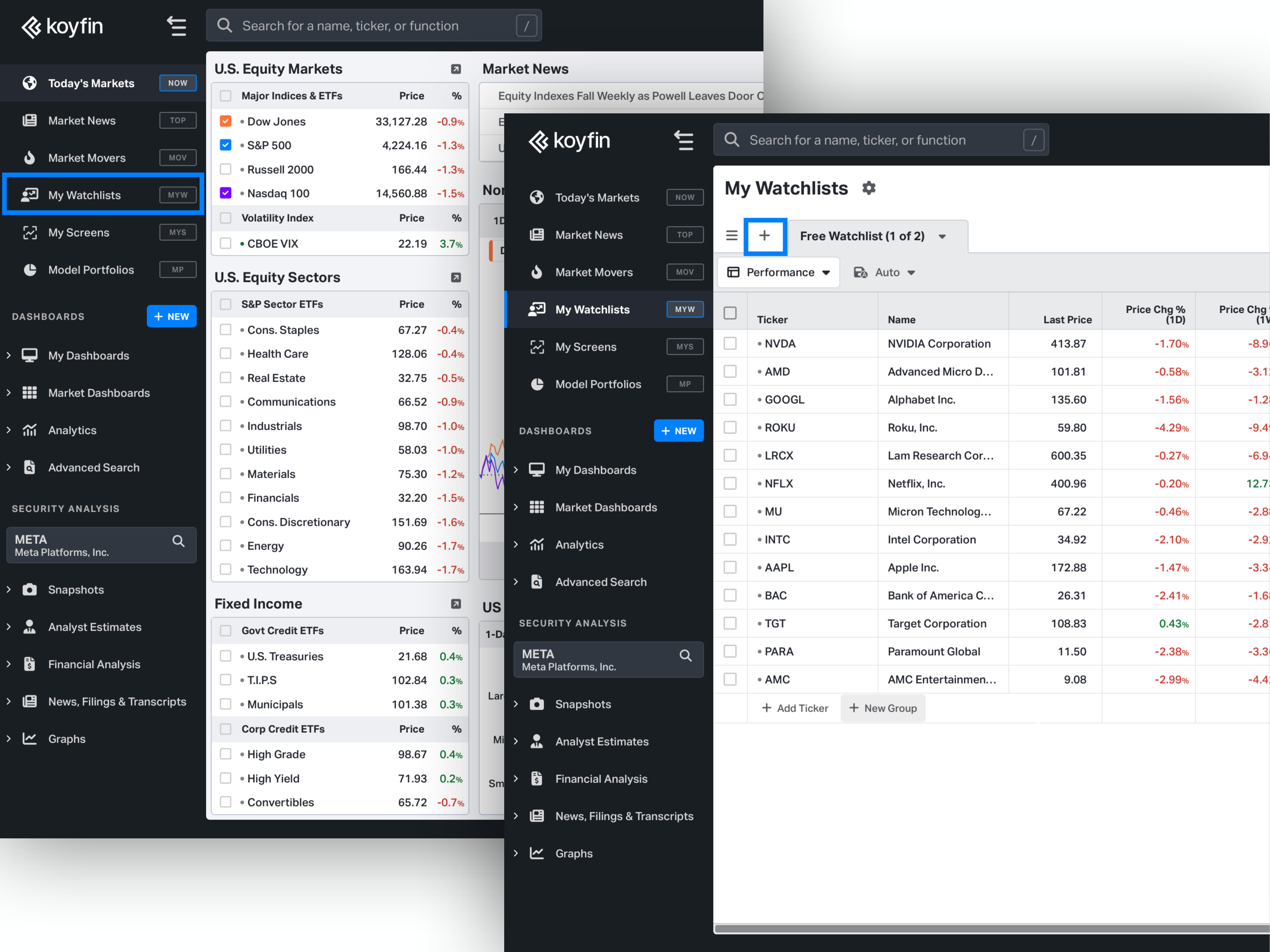
Step 3: Add Tickers. Click ‘Add Ticker’, then ‘Import Securities’, then copy and paste the below list of tickers.
SMH, SOXX, XSD, IGM, PSI, FTXL
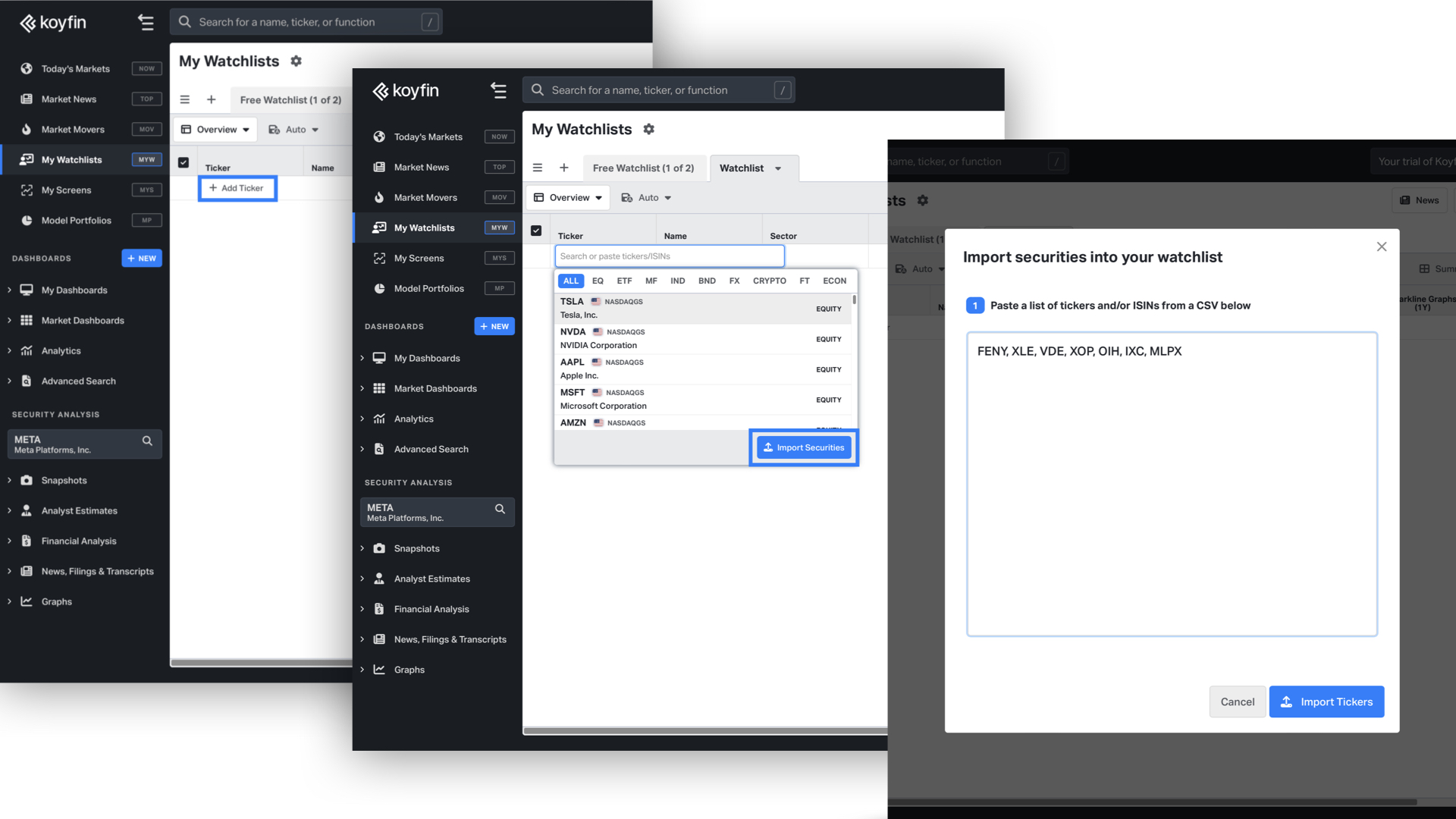
Step 4: Customize Columns. Hit the ‘Columns’ icon to add and remove columns from your watchlist table.
We have thousands of data points you can add to a watchlist, including fundamental data, price and returns data, analyst estimates, percentile ranks, security information, portfolio tools, and the ability to create your own formulas and labels.
Now your watchlist is ready, and you can use the rest of the Koyfin terminal to track and analyze these ETFs.
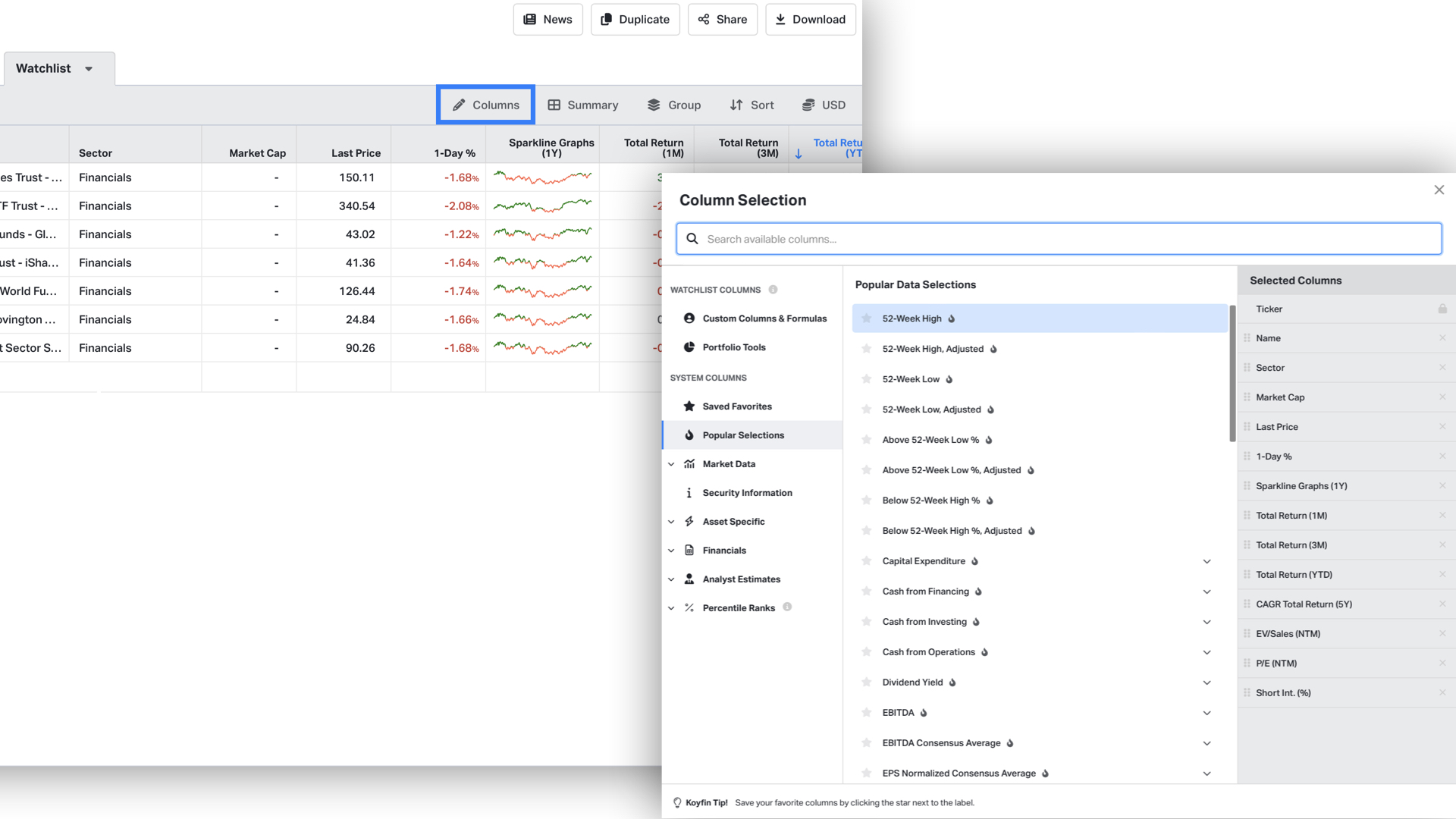
FAQ
-
What is a semiconductor?
A semiconductor is a material that has electrical conductivity between that of a conductor like copper and an insulator like glass. It is crucial for modern electronics because its conductivity can be controlled through doping, exposure to light, electric fields, or heat. Semiconductors are the foundation for microchips and transistors which are essential components in virtually all modern electronic devices.
-
What is the semiconductor industry?
The semiconductor industry encompasses companies that design, manufacture, and sell semiconductors and related hardware. It’s a cornerstone of the global technology sector, driving innovations across a multitude of industries. The industry includes a range of entities from multinational corporations that manufacture microchips, integrated circuits, and various semiconductor devices, to design firms and foundries that fabricate semiconductors for other companies.
-
What companies use semiconductors?
A vast array of companies across different sectors use semiconductors. Key sectors include:
Technology: Companies that manufacture computers, smartphones, tablets, and other consumer electronics heavily rely on semiconductors.
Automotive: Modern vehicles use semiconductors for various applications including advanced driver assistance systems (ADAS), electric power systems, and infotainment.
Healthcare: Medical devices such as MRI machines, CT scanners, and portable monitoring systems use semiconductors.
Industrial: Semiconductors are used in industrial automation, power management systems, and various other applications.
Aerospace and Defense: Semiconductors are used in navigation, radar, and other systems.
Editorial note
Our insights are derived solely from historical information and analyst predictions, employing an impartial approach. Please note that our articles do not serve as financial guidance.

